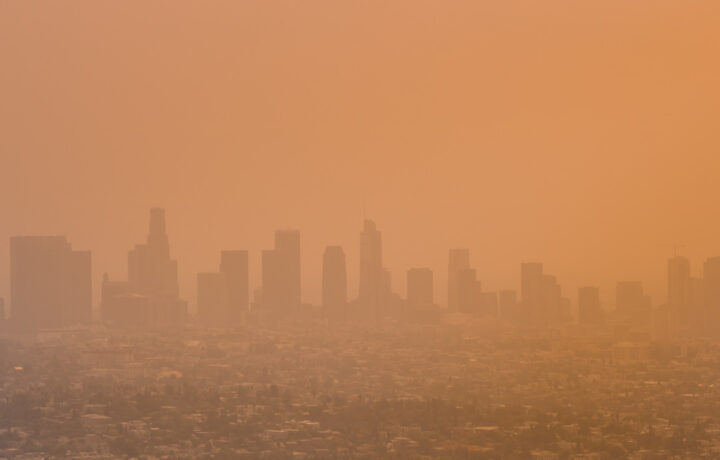The United States military is stepping up to fight the ongoing wildfires in the Los Angeles Basin, and that includes hundreds of National Guard members from California, Nevada, and Wyoming who were activated last week. Two ground firefighting teams and four military police companies from the California Guard were activated to aid in the efforts.
According to the U.S. Army, the guard members assisting on the ground are from the U.S. Army National Guard’s 330th Military Police Company and the 40th Military Police Company, 49th Military Police Brigade. The guard has begun to work alongside local law enforcement to maintain order and support communities affected by the wildfires.
“Providing support to civil authorities is a valued part of our homeland defense mission. We’re well-practiced and in position to support the Federal Emergency Management Agency, National Interagency Firefighting Center, and the state of California to assist the many citizens in need,” said U.S. Air Force General Gregoary Guillot, commander of U.S. Northern Command.
March Air Reserve Base, about 60 miles east of Los Angeles in Riverside County, was set up to serve as a staging base for efforts by the Federal Emergency Management Agency (FEMA).
On Sunday, California’s Governor Gavin Newsom today announced he has increased California National Guard personnel activated to support the response efforts to a total of about 2,500 service members.
“The men and women of the California National Guard have been on the ground since day one – not only fighting fires, but also assisting with public safety efforts in communities devastated by these fires,” said Newsom. “We thank them for their efforts to keep our communities safe.”
Active Duty Marines Now Helping
The U.S. Department of Defense (DoD) announced that around 500 active-duty United States Marines and a variety of equipment were being readied last Friday to assist.
“As announced by the president, 500 active-duty personnel currently stationed at Camp Pendleton, California, are preparing to support requests from federal and state authorities with route clearance, commodity distribution, search and rescue, rotary wing, airlift and general support, as requested,” said Sabrina Singh, DoD spokesperson.
U.S. Navy and National Guard Choppers
As of last Friday, the U.S. Navy was preparing to provide 10 helicopters that are being fitted with delivery buckets to assist with the ongoing aerial fire suppression efforts. The Navy typically employs those helicopters to carry troops out of combat zones and does not usually assist with civilian firefighting efforts. However, the service has an agreement with CAL FIRE.
The aircraft and aircrews were being sent from California’s Naval Station North Island, Marine Corps Air Station Camp Pendleton, and Marine Corps Air Station Miramar.
“Under a long-standing memorandum of agreement with CAL FIRE, active-duty units in Naval Region Southwest are prepared to provide aircraft and aircrew to support the firefighting efforts,” Singh added. “These units are trained and annually certified by CAL FIRE to provide supplemental firefighting capability when requested by the state of California and approved by the [secretary of defense.]”
The National Guard announced on Friday that it will also be deploying 10 helicopters that will be used in firefighting and search and rescue operations. The number of helicopters from the Guard is expected to increase.
C-130s On the Way
State authorities have also begun to deploy eight Modular Aerial Fire Fighting Systems (MAFFS) equipped C-130 aircraft. As many eight of the aircraft have begun to fly firefighting missions.
“MAFFS units fit inside C-130 airplanes without requiring structural modification,” the Air Force website explained. “This allows the units to be loaded on short notice. It takes about two hours to load a MAFFS unit onto the C-130.”
The cargo plane can take to the air and drop the fire retardant from an altitude of about 150 feet through a discharge tube located in place of the left rear paratroop door of the aircraft. The full load of 3,000 gallons weighing 28,000 pounds can be discharged in less than five seconds.
“The retardant covers an area one-quarter of a mile long and 60 feet wide,” the Air Force added. “After the plane discharges its load, and returns to an air tanker base, it can be refilled and airborne again in less than 20 minutes.”
Military Precision During and Following a Disaster
The National Guard is often called up after a disaster, such as the devastating hurricanes that hit Florida, Georgia, and North Carolina last fall.
Responding to a fire is a bit different, and in the case of Southern California, it is further complicated due to the size and scope of the disaster.
“There’s so many different fires raging in California,” Singh said. “We have to work in coordination with the state and FEMA when it comes to how we address each single fire. And not just the fires; it’s the road clearing, it’s the management, it’s how people get back to their homes. All of this knits together very carefully and in an intricate way that is going to take a little time, it’s going to take some coordinating.”
Singh added that Pentagon resources work best when there is a coordinated plan in place to make sure they are used the most efficiently.
“You just don’t want to surge a bunch of capability and resources into a region without a full plan,” she said. “So that’s what we’re doing, and we’re working very closely with the state to make sure that we’re getting their needs met.”




